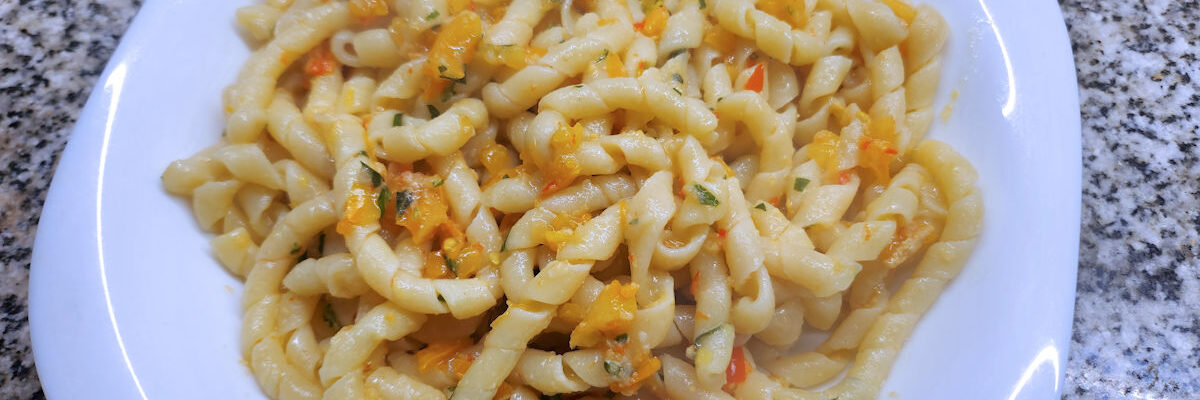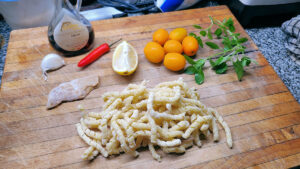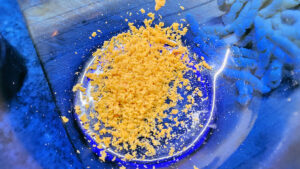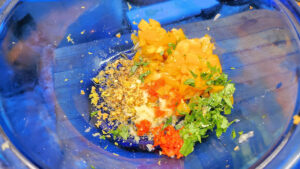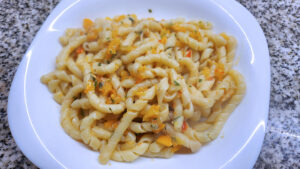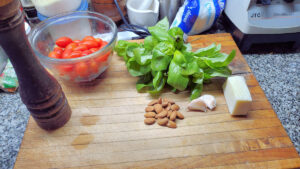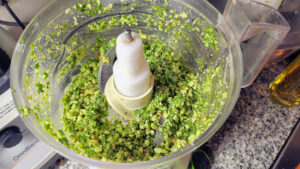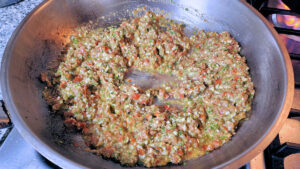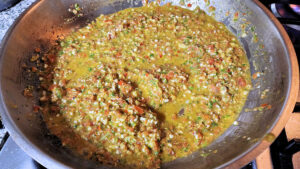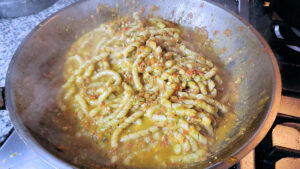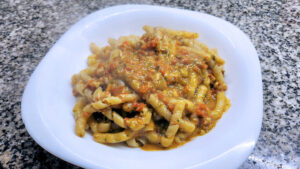For most of my life I’ve thought about something that has a corkscrew shape as a “spiral”. But it turns out that’s wrong – something maybe that was buried in the back of my mind from school years, but never connected. A spiral is a two dimensional figure, like a drawing on paper. When you add the third dimension, turning it into a corkscrew shape, it’s a “helix”. It hadn’t occured to me that the two were different. Now I know. And you do too if you didn’t already.
All of this leads us to a pasta shape from the Trapani region of Sicily, busiate, named for a local reed, busa, that was traditionally used to diagonally wrap a fettuccine-like pasta around, creating a helix. The same shape, and name, is used in Calabria as well, and today I’m offering up two takes on this shape, one traditional and one modern.
I’m starting with the ostensibly modern one. I’m not sure that it’s really that modern, it’s more of a combination of fairly typical flavors from the Amalfi Coast. It’s a pasta I read about in the New York Times made with spaghetti, so I’m making up pairing it with busiate. The recipe was intended to highlight two lesser known ingredients, bottarga and colatura di alici. The latter, Italian fish sauce, is a typically Neapolitan ingredient that I wrote about in detail awhile back for a pasta that featured it.
The former is salt cured fish eggs, a classic ingredient in Sicily and Sardinia, though with a history that goes back three millennia to the Nile Delta. Typically from grey mullet or Mediterranean tuna, the egg sacs are basically buried in salt for anywhere from a few hours to a few days to draw out all the moisture, and then air-dried for more days. There are more how-tos out there than I care to think about, and I just trusted my gut in making my own – buried in salt for about 48 hours, then air-dried with a light coating of salt for a week. It’s a work in progress.
It’s firm enough to grate, kind of like a fairly hard cheese.
And here, the rest of the ingredients either grated or finely chopped – garlic, chili, lemon zest, yellow tomato, basil, and then a splash of the colatura di alici. I also tried adding some of the lemon juice to part of the final dish, but found it too intense – I’d stick with just the zest.
The sauce is basically uncooked. I put it in a small pan and added a little of the boiling pasta water with its starch and salt, just to warm it up and also to make it a little… clingy, for when I added the pasta to it.
Yum. Like, really, yum.
On to the real classic recipe. In truth, in Sicily, probably the way you’d find busiate served 90% of the time, alla pesto trapanese, or, with Trapani style pesto – locally, in Sicilian dialect, called agghiata trapanisa. Here we have cherry tomatoes, basil, almonds, garlic, black pepper, and pecorino cheese. Of course, olive oil too.
You could pound everything down in a mortar and pestle to be really authentic, but I’m using a food processor. Here, I first ground the almonds, then added in the garlic, cheese, basil, black pepper, and olive oil to make a coarse paste. Separately I more or less pureed the cherry tomatoes. To be really authentic, they’re supposed to be peeled – or is that really authentic? I have trouble imagining all those Sicilian grandmothers sitting around peeling small tomatoes.
Again, into a pan, but not cooking it…
Just adding a ladle of the hot pasta water to emulsify it and warm it up.
Then tossing the cooked pasta with it.
And, serving it!
Again, really good. And interesting, I was thinking about a post I made awhile back about the unusual combo that appears here in Buenos Aires on some Italian menus of pasta with basic tomato sauce and pesto. It works, but was something I just haven’t seen elsewhere. And yet, in a sense, that’s what we have here, just all tossed together.
Personally, while I liked both dishes, I think I liked the lemon-bottarga pesto a little better. Just a flavor profile I like a lot. But I’d happily eat or serve either again!
